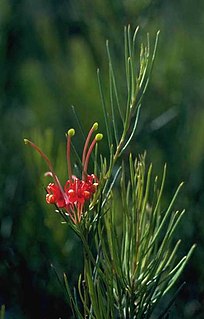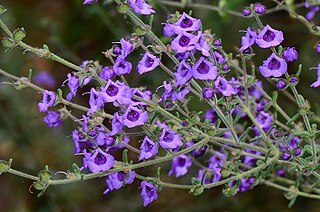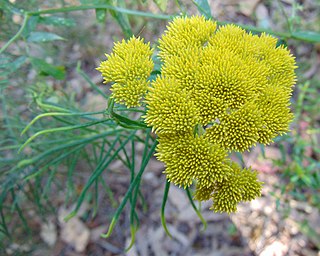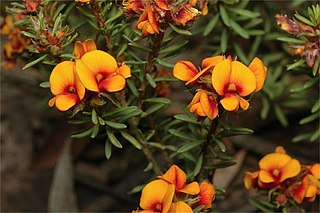
Grevillea acuaria is a species of flowering plant in the family Proteaceae and is endemic to the south-west of Western Australia. It is a rounded, bushy to erect shrub with spreading linear to narrowly elliptic leaves and red flowers arranged in small clusters.

Pultenaea muelleri, commonly known as Mueller's bush-pea, is a species of flowering plant in the family Fabaceae and is endemic to Victoria, Australia. It is a dense shrub with hairy stems, elliptic to narrow egg-shaped leaves with the narrower end towards the base, and yellow and red flowers arranged singly or in pairs on the ends of short side shoots.

Prostanthera hirtula, commonly known as hairy mintbush, is a species of flowering plant in the family Lamiaceae and is endemic to the south-eastern continental Australia. It is a strongly aromatic, densely hairy, spreading shrub with narrow egg-shaped leaves and dark mauve flowers, and that grows in exposed, rocky sites.
Cassinia compacta is a species of flowering plant in the family Asteraceae and is endemic to eastern Australia. It is a shrub with densely hairy stems, linear leaves and heads of yellow flowers arranged in dense corymbs.

Cassinia leptocephala is a species of flowering plant in the family Asteraceae and is endemic to New South Wales. It is a large, woody shrub with hairy, reddish stems, stiff linear leaves, and heads of pale yellow flowers arranged in a dense corymb.

Cassinia trinerva is a species of flowering plant in the family Asteraceae and is endemic to south-eastern Australia. It is an erect shrub or small tree with hairy stems, narrow lance-shaped leaves, and flower heads arranged in dense corymbs.

Cassinia longifolia, commonly known as shiny cassinia, is a species of flowering plant in the family Asteraceae and is endemic to eastern Australia. It is an erect, aromatic shrub with sticky, hairy foliage, linear or oblong to narrow lance-shaped leaves, and heads of creamy-white flowers arranged in a dense corymb.
Cassinia telfordii is a species of flowering plant in the family Asteraceae and is endemic to eastern Australia. It is an erect shrub with hairy young stems, linear leaves and corymbs of up to several hundred yellow to cream-coloured flower heads.
Cassinia straminea is a species of flowering plant in the family Asteraceae and is endemic to eastern Australia. It is an erect shrub with hairy young stems, linear leaves and corymbs of up to several hundred flower heads.
Verticordia polytricha, commonly known as northern cauliflower, is a flowering plant in the myrtle family, Myrtaceae and is endemic to the south-west of Western Australia. It is an erect, bushy shrub with linear leaves and dense heads of white flowers in late spring and summer.
Leptospermum roei is a species of spreading shrub that is endemic to the southwest of Western Australia. It has thin, fibrous bark, long egg-shaped to narrow wedge-shaped leaves, white or pink flowers and small fruit that are shed with the seeds.
Cassinia diminuta, commonly known as dwarf cassinia, is a species of flowering plant in the family Asteraceae and is endemic to Victoria in Australia. It is a small, erect, aromatic shrub with spreading, needle-shaped leaves that are covered with cottony hair on the underside, and corymbs of up to two hundred heads of flowers arranged in corymbs.
Cassinia complanata, commonly known as smooth cassinia, is a species of flowering plant in the family Asteraceae and is endemic to south-eastern Australia. It is a shrub with sticky, densely hairy stems, narrow linear to cylindrical leaves and heads of small flowers arranged in corymbs.
Cassinia ozothamnoides, commonly known as cottony haeckeria, is a species of flowering plant in the family Asteraceae and is endemic to Victoria, Australia. It is an erect shrub with hairy branchlets, linear leaves and corymbs of up to two hundred flower heads.
Cassinia rugata, commonly known as wrinkled dollybush, or wrinkled cassinia, is a species of flowering plant in the family Asteraceae and is endemic to south-eastern Australia. It is a spreading to erect shrub with hairy, slightly sticky branchlets, oblong to narrow elliptic leaves and corymbs of up to three hundred flower heads.
Cassinia tegulata commonly known as avenue cassinia, is a species of flowering plant in the family Asteraceae and is endemic to a small area near the Victoria-South Australia border. It is a small to medium-sized shrub with hairy foliage, needle-shaped leaves, and dense heads of off-white to cream-coloured flowers arranged in corymbs.
Cassinia thinicola is a species of flowering plant in the family Asteraceae and is endemic to coastal New South Wales. It is a compact shrub with hairy young stems, needle-shaped to slightly flattened leaves, and corymbs of up to 150 flower heads.

Hibbertia mucronata is a species of flowering plant in the family Dilleniaceae and is endemic to the south of Western Australia. It is an erect shrub with hairy branches, crowded, thick, tapering linear leaves ending in a sharp point, and golden yellow flowers with five stamens fused at their bases, all on one side of two densely hairy carpels.

Pultenaea largiflorens, commonly known as twiggy bush-pea, is a species of flowering plant in the family Fabaceae and is endemic to south-eastern continental Australia. It is a rigid, erect shrub with narrow egg-shaped leaves with the narrower end towards the base, and bright yellow and crimson flowers.

Pultenaea subspicata, commonly known as low bush-pea, is a species of flowering plant in the family Fabaceae and is endemic to south-eastern continental Australia. It is a low-lying, prostrate or mat-forming shrub with elliptic leaves and yellow to pink and orange-red, pea-like flowers.









